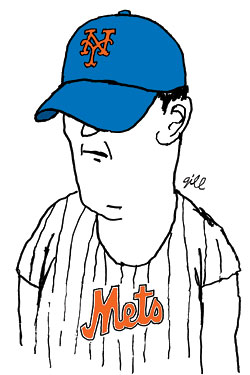
You might not have noticed while sifting through all of the Alex Rodriguez Sturm und Drang—in the span of one month, A-Rod’s tale has referenced about five different Shakespearean plays, and he’s barely been on the field—but there is, in fact, another Major League Baseball team in town. The New York Mets and their fans are not offended by your neglect. They’re used to it.
The Mets are having their dullest spring training in recent memory, which, when you consider how their last two seasons have ended, is kind of insane. Almost all of their star players have been battling it out for their various nations in the World Baseball Classic, leaving their skeletal Grapefruit League lineup full of people like Darren O’Day and Jose Coronado. Bill Parcells and Miami Dolphins coach Tony Sparano came to visit camp, but were so bored they spent more time watching the Baltimore Orioles. (Mets PR guy Jay Horwitz lamely promised Sparano an autographed Rene Rivera baseball.) Legitimate coverage was devoted to the tragic news that Giuseppe Franco’s “ProCede” hair-replacement tonic would no longer be sponsoring SNY Mets telecasts. (We will all miss the “Beverly Hills Salon Owner.”) The beat reporters seem to be suffering from narcolepsy, and so do the fans. The ones around, anyway: Attendance at Tradition Field is down 15 percent from last year. The only real news coming out of camp has been the breathless speculation about Johan Santana’s elbow.
The Mets seem pleased about this so far—before he left to split time with newfound pal Chipper Jones on the USA WBC team, third-baseman David Wright said that camp was “the way it’s supposed to be: quiet”—and considering the madness enveloping their rivals/colleagues from the Bronx, it’s difficult to blame them. But despite the radio silence in Port St. Lucie, there ought to be a greater sense of urgency surrounding the team. It’s a critical year for the Amazin’s. Maybe the most critical of the decade.
Greg Prince, author of the new book Faith and Fear in Flushing, based on the eponymous blog he co-authors with Jason Fry, has a theory about his beloved Mets he calls “The Legacy of Yadier Molina.” In the 2006 National League Championship Series, the Mets—fielding their most exciting, most dominant team since the days of Doc Gooden and Darryl Strawberry—lost in the most heartbreaking fashion imaginable to the aging, 83-win St. Louis Cardinals, thanks mostly to a ninth-inning home run by the Cardinals catcher off the since-exiled Aaron Heilman. The reason that series was so crushing to the Mets and their fans, more so than even the World Series loss to the Yankees in 2000, was because that was the definitive Mets team: young, fun, energetic, loopy, and, most of all, “scrappy” (that great baseball adjective). While the Yankees were plodding along like the monolith they’ve become, the Mets were supposed to be sleek and streamlined.
Wright was the all-American, the Mets version of a young Mantle—smiling, chiseled, shining. Carlos Beltran had overcome his own Mets drama, staving off a previous season of boos to look like the all-around superstar the Mets thought they were getting in the first place. Carlos Delgado was the quixotic, fascinating slugger, the political activist who spoke out against President Bush and the Iraq War and, before coming here, famously refused to stand for “God Bless America.” And standing as the symbol of it all was shortstop Jose Reyes, a hyperactive 23-year-old wunderkind whose pure joy at playing the game of baseball was exceeded only by the joy of those watching him slide headfirst into third after knocking one into the Shea Stadium gap. These Mets were brash but respectful, fresh but experienced, playful but focused. This was the team that was going to end Mets fans’ suffering. It had to be them.
Until, that is, Molina’s home run, and Carlos Beltran’s frozen, slack-jawed gape as Adam Wainwright’s third strike fluttered past him, and euphoric Cardinals veterans pranced around the Shea infield. The anticipated—no, expected—Mets championship never happened. Mets fans had forgotten that part of the Mets’ identity is to fail in the most grueling way possible. They were about to be reminded, again, and again.
With that loss, Prince writes, “the Mets dug themselves into a hole from which they’ve never climbed out. It’s always October 19, 2006. Ownership and general management has proceeded as if this is forever a World Series club in every sense but that of accomplishment.” The evidence bears him out. Two years ago there was the “we’ll get it this time” off-season, with few moves made, management assuming the team would just repeat what it did the year before. Last year was the “we just need one starting pitcher” off-season, with the acquisition of Johan Santana masking the dam holes quietly tearing open everywhere else. Now the “we just need to fix the bullpen” off-season has been concluded, with J. J. Putz and Francisco Rodriguez hauled in and pretty much everything else left intact. General manager Omar Minaya has acted like his team is perpetually one piece away, while other pieces, the ones he wasn’t looking at, slowly erode. And he’s just about out of time.
All those guys—Reyes, Wright, Delgado, Beltran—are still there. But they’re older now, and less innocent. Their names are no longer attached to discovery and goofy bliss. Their names are now attached to The Collapses.
Oh, yes. Those Collapses.
According to the stat gurus at Baseball Prospectus, the odds of the Mets blowing their National League East lead in 2007 were 500-to-1. Last year, they were a more reasonable, but no less baffling, 12½-to-1. According to the pain gurus that are Flushing fans, such odds were merely “unfathomable.” It’s difficult to come up with an ending to any season worse than what has happened to the Mets—it would likely require a player striking out in the ninth inning, then bursting into flames—and they went through it twice. No fan should have to endure such punishment.
Understandably, the Mets have been eager to erase the memory of the last two seasons, which is probably why, fear of injury aside, they like having the distraction of the World Baseball Classic and the quiet camp. (Though expect, in the wake of his performance in the WBC, the calls for Pedro Martinez to reach deafening decibels in the next week.) But eventually the season’s going to start, and the Mets are going to lose a game they probably should have won, and The Fear will return. It’s never been a more perilous time to be a Mets fan. Though sometimes I wonder if they like it that way.
At a certain level, Mets fans’ love of their underdog status in New York has never made sense. The Mets had the second-highest payroll in baseball last year and employ three of the most expensive players in the game. When they wanted Johan Santana, they just went out and got him. This will never happen for the Kansas City Royals or, for that matter, any team that doesn’t play in New York, Chicago, Boston, or Los Angeles. The Mets fans have embraced their status as the Other team in New York, because it salves their wounds with meaning: Watching the Mets continuously fail to push the rock up the hill gives cheering for the franchise gravitas and depth, as opposed to the arrogance they perceive in their Yankee-fan counterparts.
But it’s a fallacy, and one wonders, with a shiny new ballpark, how long they’ll be able to keep up the illusion. It’s a lot easier to pretend to be the scrappy overachievers when you’re playing in a rotting Robert Moses relic with an upper deck so high you could wave to the people in planes passing overhead. Can Mets fans keep this up when their team is selling Belgian frites in the cheap seats and offering “multiple sit-down, climate-controlled restaurants, bars, clubs, and lounges”? I posit that this center cannot hold. What if the Mets aren’t the cursed underdogs their fans believe them to be? What if they’re simply disappointing millionaires holding out for new contracts while the rest of us watch our retirement plans evaporate? What if the warm fuzzies fade? What if enough is enough? What then?
That’s the scary question this year might answer. Can the Mets, as a franchise, possibly survive another collapse, or even a frustrating, listless season? Will fans, already staying away from spring-training games like never before, decide that a flailing Mets team isn’t worth their shrinking entertainment dollar? It was just five years ago that the Mets were averaging 28,979 fans a game. It won’t go that low this year unless we all relive the Dust Bowl, but if it so much as approaches that number in the next couple of seasons—which, if the Mets don’t finally break through, very well might happen—it will be a disaster for the Mets organization.
Which makes this season so much more vital to the Mets than it is to the Yankees, or any other Mets team in recent memory. Right now is the calm. But as many a cinematic soldier has been known to say: “It’s quiet out there. Too quiet.”
You can write to Leitch at will.leitch@nymag.com.
